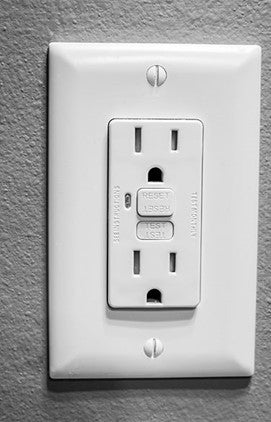The following information pertains to electric systems in North American buildings. Please research further information specific to your local electrical systems. We strongly recommend having a professional electrician perform EVSE (Electric Vehicle Supply Equipment) installations and other electrical work.
What is Ground (in electricity)?
Ground (in electricity) provides an essential safety measure for all electrical systems, EVSE installations included. To understand grounding, we first need to look at a few basic concepts in electricity.
Electricity Basics
Electric currents (electrons in motion) power the modern world, from allowing motors to spin, creating heat in heaters, and performing all the tasks we expect from our electrical devices. Electric currents travel through circuits to get to their destinations.
Circuits:
-
Electricity will only flow through closed circuits. This means the circuit must have a path to carry electrons to the load, and a return path to carry electrons back to its source.
-
Electricity will always want to return to its source. The Earth is composed of electrically conductive soil and rocks. This property allows electrical currents to flow into the Earth and then dissipate. However, in its determination, electricity will take any available paths to complete a circuit.
-
Electricity will always prefer taking the return path with the lowest resistance. This leads us to the Ground as a safety measure in electrical systems.
Electrical Control Panel
Typical electrical control panels consist of three types of wires: the hot wire, the neutral wire, and the ground wire.
Hot Wire: Hot wires typically feed electricity from the power supply source to its destination.
Neutral Wire: Neutral wires provide a return path for the electricity from its destination to its source.
Ground Wire: Ground wires have low resistance path and do not conduct electricity under normal circumstances. If needed, they will provide an alternative circuit return path for the electricity and are stationed in the control panel as an emergency safety measure.

GFCI receptacle

Standard receptacle
What is a Ground fault?
Ground faults are conditions where energized conductors in a circuit make inadvertent contact with the frame of an appliance or equipment. This condition, if unprotected, results in electric shock, or, in the most extreme cases, electrocution.
Safety and Ground
Suppose the hot wire touches the control panel casing (typically metal, a great conductor of electricity), and parts of the internal electrical wiring become exposed. Because electricity prefers the path of least resistance, it will return to its power supply source through the ground wire connection path of the control panel. In these instances, the ground wire’s low resistance will cause a significant surge of electrical currents, tripping the breaker and forcing the circuit to switch itself off. In scenarios where the control panel is either not properly grounded, or when the ground connection is missing, the return current will take path through any nearby conductive objects or when a human gets in contact with that control panel.
Ground Faults
A ground fault occurs whenever electricity strays from its circuit path. In this case, a simple example would be a cracked drainage pipe. If rainwater is supposed to travel through the drainage pipe, and the tube has a crack, it would leak into areas where it was never meant to go. In the case of a ground fault, if electricity strays (leakage current) from its circuit, it is still traveling somewhere. That somewhere could be a human body, risking severe or even fatal injuries. A ground will provide the electricity with an alternate return path, preventing high-voltage electric shocks, electrocution, and other potentially serious or fatal injuries.
Ground Fault Circuit Interrupter (GFCI)
A GFCI provides an additional safety measure in electrical systems. Its job is to monitor the flow of electrical currents in the circuit. If there is a difference between the sum of currents flowing in and out of the circuit, the GFCI can detect this and automatically open the circuit and stop the power flow.
Safety and Enphase EVSE
Enphase charging stations adhere to all safety requirements including the implementation of various protective circuits. These circuits, including the Ground Monitor and the Charge Circuit Interrupt Device (CCID), work cohesively to ensure safe and reliable charging operations for electric vehicles (EVs). The following sections elaborate on the specific functions and features of these protective mechanisms in detail.
Ground Monitor
The first protection circuit is a ground detector, ensuring a low resistance path to the ground exists. It will turn off the charging station if it senses that a ground wire has been disconnected or the resistance is too high. A connected vehicle cannot charge until a low resistance Earth ground has been re-established. An Enphase EVSE will illuminate a solid red ‘Power Fault’ indicator on the front to inform the user of the potential wiring safety issue.
Charge Circuit Interrupt Device or CCID
Known as Enphase’s version of the GFCI, this ground protection circuit is built into the internal core functions of every Enphase EVSE. The CCID ensures power stays within its circuit by continuously measuring the flow of electrons and ensuring that outward flow equals inward flow. It will turn off a charge if a measurable number of electrons get misdirected or do not arrive at the intended destination.
Enphase EV Charger Safety Information
Since EVSE requires electrical installation and operation, several certifications that EVSE must be met before they can be installed.
Nationally Recognized Testing Laboratory, such as Intertek (ETL mark) or Underwriter’s Laboratory (UL mark), can test and certify electric vehicle charging stations.
Safety engineers at these labs perform months of extensive safety testing that the products must pass before they can be safety certified and made available to the public for sale. Only products with these marks on the manufactured product’s rating plate are safety certified.
All Enphase EV Chargers are ETL or UL listed, and ENERGY STAR® Certified, demonstrating that our products have met the requirements of widely accepted product safety standards for EV charging stations.


